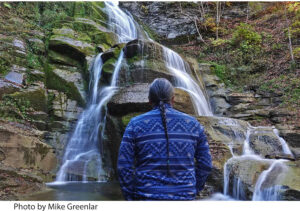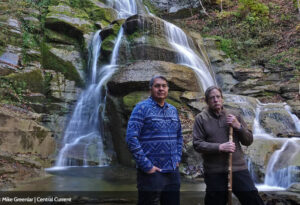
Central Current
By Patrick McCarthy
Standing at the bank of a clear pool, Hazel Powless and Alma Lowry stared at the white waters falling from fifty feet above them.
The waterfall, one of the Fellows Falls of the Tully Valley, feeds the main tributary to Onondaga Creek. Relentlessly flowing, the water rushed over rocks and moss.
For the first time since the Onondaga Nation reacquired 1,000 acres of land, a group of four — two lawyers and two members of the Nation — trekked to the waterfall.
The winding walk to the bank followed portions of a sometimes-steep logging road, its path covered in damp, yellow-brown foliage and strewn with fallen branches.
Joe Heath, the Onondaga Nation’s legal counsel, leaned on his walking stick alongside Powless and Lowry on the water’s muddy bank. For years, Heath and Lowry, an environmental lawyer, worked with Powless, a member of the Haudenosaunee Environmental Task Force, to fight for the reacquisition of more than 1000 acres of their ancestral lands from Honeywell International. They had walked these acres but always under a Honeywell employee’s supervision.
This was the trio’s first visit to this waterfall since finalizing the land transfer earlier this month.
“It hasn’t sunk in,” Heath said. Lowry and Powless agreed.
A fourth member accompanied the hiking party but had leapt rocks across the creek to scramble up a large boulder and stand directly beneath the waterfall. Brad Powless spent fifteen minutes staring at the cascade.
Overhead, mist and spray splashed a moss-adorned rock face adjacent to the fall. Hidden within that damp refuge resided dozens of Chittenango ovate amber snails. This increasingly endangered species is native only to Chittenango Falls, but the Onondagas are collaborating on an on-going project to create a second habitat for the rare snails at this waterfall.
Brad Powless eventually hopped back to rejoin the group, flashing a beaming smile while describing the waterfall’s roar. The steady rumble expressed the power of these waters, which represent a crucial resource for the Onondaga Nation and natural life alike.
A council member and Hazel’s cousin, Brad is the son and grandson of former Onondaga Nation chiefs Irving Powless, Jr. and Irving Powless, Sr.
In a 2011 tribute to his grandfather titled “Fishing with Grandpa,” Brad Powless detailed how the effects of salt mining had transformed the Creek his grandfather loved to fish – whose waters contained so many fish, the elder Powless thought he could cross by walking on their backs – into something murky and unrecognizable.
 Downstream, native brook trout have struggled in the warmer, polluted waters of the Onondaga Creek. These headwaters, though, have the cold, clear water essential for a thriving brook trout population, and the nation is already working to restore this species that was historically the main fish for Onondaga fishermen.
Downstream, native brook trout have struggled in the warmer, polluted waters of the Onondaga Creek. These headwaters, though, have the cold, clear water essential for a thriving brook trout population, and the nation is already working to restore this species that was historically the main fish for Onondaga fishermen.
Powless was optimistic about returning the brook trout to their former abundance. Walking back from the waterfall, he recalled fond childhood memories of fishing with his grandfather, former Onondaga chief Irving Powless, Sr.
“We’d have to go off the nation to go fishing, because we couldn’t fish at home anymore,” Powless said. “Probably, my grandfather had been here before, he was following the stream up here.”
Soon, these headwaters could become the nearby fishing locale Powless lacked as a kid.
“They’d probably be so happy about this,” Powless said. “Both my dad and my grandfather.”
